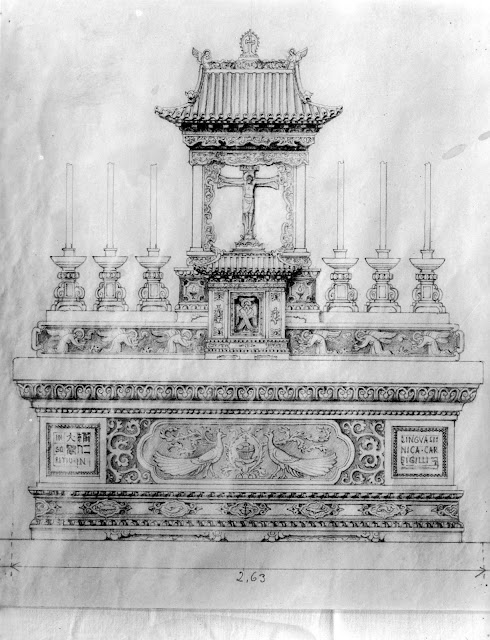 |
| The tomb of Pius XI designed by Dom Adelbert |
Dom Adelbert was resident in China for five years between 1927-1932 during a time when the Holy See was focusing more on the concept of inculturation or what was then referred to as "localization" or "indigenization" -- i.e. adapting the Christian idiom to localized, cultural vernaculars and influences while still retaining core Christian roots and messages. Attending the Catholic University of Peking, Dom Adelbert studied Chinese architecture as part of this process and would design various Catholic structures -- some of which were built, others which weren't such as a proposed design for the cathedral for Haimen. After his time in China, Dom Adelbert taught a course on "Christian Art in the Mission Countries" at the Pontifical College Urbano de Propaganda Fide between 1940-1948 before having his career in this regard cut short by a stroke that he would suffer from in 1949.
 |
| Dom Adelbert Gresnigt, O.S.B. in China |
Dom Adelbert was tasked by the then Apostolic Delegate of China, Archbishop Celso Constantini (+1958), with shifting the Catholic architectural and artistic approach in the region from nineteenth century gothic revivalism to the development of a true Sino-Christian style; a task he felt particularly important in terms of Catholic outreach to the native Chinese population.
These altars reflect what I would consider an authentic approach to inculturation in liturgical art; inculturation not as manifest by the absence or significant diminution of recognizable Christian meaning and symbolism, but rather an approach characterized by taking the essential Christian substance and core schema and merging it and layering it with stylistic influences taken from the local cultural vernacular in a way that creates a harmonious whole. In many ways, there is a clear parallel to be found here between authentic approaches to inculturation in liturgical art and the authentic approach taken toward modernity that we can find in "Other Modern" work. There too it is about a modernity that does not come at the expense of the Christian tradition.
Here then are three altars by Dom Adelbert that fall into this precise approach. Each of the three altars comes in one of the more popular forms since the time of the Council of Trent, the Exposition Throne altar which combines the altar, gradines, central tabernacle and an exposition throne space used alternately for an altar cross or for exposition of the Blessed Sacrament -- a style particularly popular in the north of Italy and parts of Southern France. What you will see in each of the examples is that the basic form is recognizably and traditionally Christian, even 'Tridentine," as are the symbols, however the stylistic details and ornament that are layered over top of these are very clearly rooted in the local cultural and artistic vernacular of the Chinese and their historic architecture.
 |
| Adelbert Gresnigt. No date. Société des Auxiliaires des Missions (SAM) China Photograph Collection, Whitworth University Library, Spokane. |
 |
| Adelbert Gresnigt. No date. Société des Auxiliaires des Missions (SAM) China Photograph Collection, Whitworth University Library, Spokane. |













